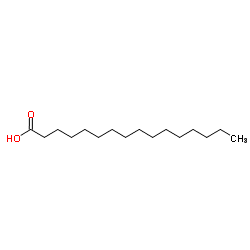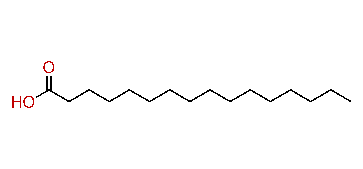Formula C16H32O2 Melting point 62.9 °C Boiling point 351 °C Appearance white crystals | Molar mass 256.4241 g/mol IUPAC ID hexadecanoic acid Density 853 kg/m³ | |
 | ||
Palmitic acid, or hexadecanoic acid in IUPAC nomenclature, is the most common saturated fatty acid found in animals, plants and microorganisms. Its chemical formula is CH3(CH2)14COOH. As its name indicates, it is a major component of the oil from the fruit of oil palms (palm oil). Palmitic acid can also be found in meats, cheeses, butter, and dairy products. Palmitate is a term for the salts and esters of palmitic acid. The palmitate anion is the observed form of palmitic acid at physiologic pH (7.4).
Contents

Aluminium salts of palmitic acid and naphthenic acid were combined during World War II to produce napalm. The word "napalm" is derived from the words naphthenic acid and palmitic acid.

Occurrence and production

Palmitic acid was discovered by Edmond Frémy in 1840, in saponified palm oil. This remains the primary industrial route for its production, with the triglycerides (fats) in palm oil being hydrolysed by high temperature water (above 200 °C or 390 °F), and the resulting mixture fractionally distilled to give the pure product.

Palmitic acid is naturally produced by a wide range of other plants and organisms, typically at low levels. It is naturally present in butter, cheese, milk, and meat , as well as cocoa butter, soybean oil, and sunflower oil. The cetyl ester of palmitic acid (cetyl palmitate) occurs in spermaceti.
Biochemistry
Excess carbohydrates in the body are converted to palmitic acid. Palmitic acid is the first fatty acid produced during fatty acid synthesis and is the precursor to longer fatty acids. As a consequence, palmitic acid is a major body component of animals. In humans, one analysis found it to make up 21–30% (molar) of human depot fat, and it is a major, but highly variable, lipid component of human breast milk. Palmitate negatively feeds back on acetyl-CoA carboxylase (ACC), which is responsible for converting acetyl-CoA to malonyl-CoA, which in turn is used to add to the growing acyl chain, thus preventing further palmitate generation. In biology, some proteins are modified by the addition of a palmitoyl group in a process known as palmitoylation. Palmitoylation is important for membrane localisation of many proteins.
Applications
Palmitic acid is used to produce soaps, cosmetics, and industrial mold release agents. These applications use sodium palmitate, which is commonly obtained by saponification of palm oil. To this end, palm oil, rendered from palm tree (species Elaeis guineensis), is treated with sodium hydroxide (in the form of caustic soda or lye), which causes hydrolysis of the ester groups. This procedure affords glycerol and sodium palmitate.
Because it is inexpensive and adds texture and "mouth feel" to processed foods (convenience food), palmitic acid and its sodium salt find wide use in foodstuffs. Sodium palmitate is permitted as a natural additive in organic products. The aluminium salt is used as a thickening agent of napalm used in military actions.
Hydrogenation of palmitic acid yields cetyl alcohol, which is used to produce detergents and cosmetics.
Recently, a long-acting antipsychotic medication, paliperidone palmitate (marketed as INVEGA Sustenna), used in the treatment of schizophrenia, has been synthesized using the oily palmitate ester as a long-acting release carrier medium when injected intramuscularly. The underlying method of drug delivery is similar to that used with decanoic acid to deliver long-acting depot medication, in particular, neuroleptics such as haloperidol decanoate.
Health effects
According to the World Health Organization, evidence is "convincing" that consumption of palmitic acid increases the risk of developing cardiovascular disease, based on studies indicating that it may increase LDL levels in the blood. Retinyl palmitate is an antioxidant and a source of vitamin A added to low fat milk to replace the vitamin content lost through the removal of milk fat. Palmitate is attached to the alcohol form of vitamin A, retinol, to make vitamin A stable in milk.
Rats fed a diet of 20% palmitic acid and 80% carbohydrate for extended periods showed alterations in central nervous system control of insulin secretion, and suppression of the body's natural appetite-suppressing signals from leptin and insulin (the key hormones involved in weight regulation).
Palmitic acid strongly boosts metastasis in mouse models of human oral cancer cells. Among all fatty acids, it has the strongest effect in boosting the metastatic potential of CD36+ metastasis-initiating cells.
Plant and animal based Palmitic acids vary in their structure and act differently when consumed.
